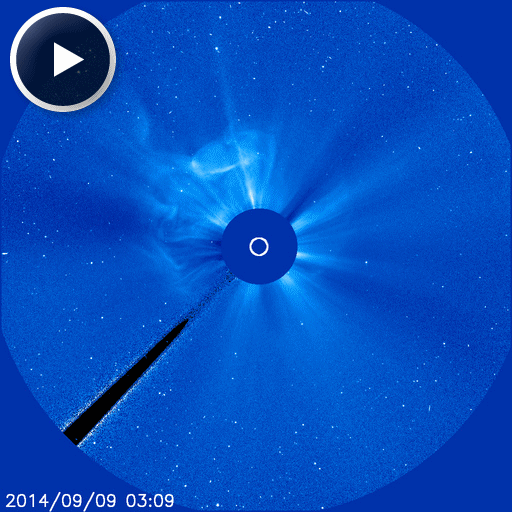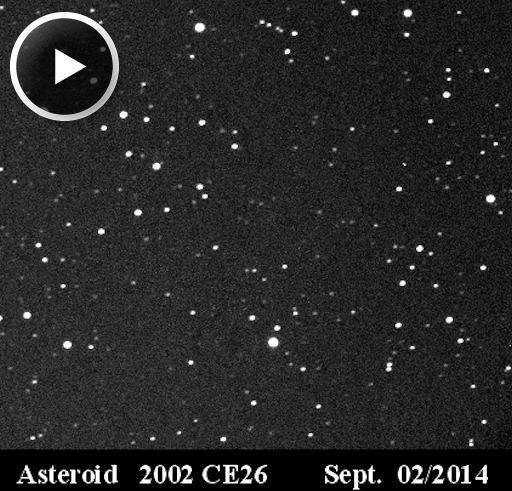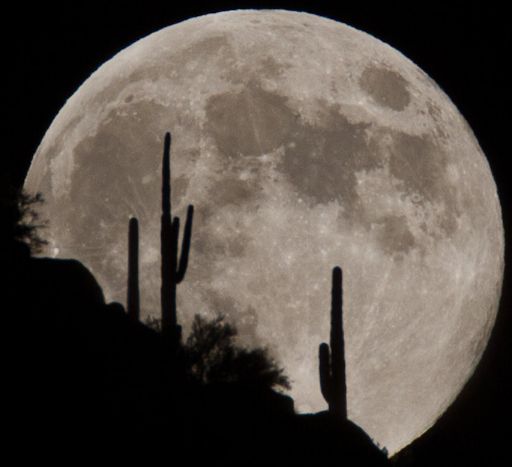When is the best time to see auroras? Where is the best place to go? And how do you photograph them? These questions and more are answered in a new book, Northern Lights - a Guide, by Pal Brekke & Fredrik Broms. | | |
CHANCE OF FLARES: The odds of a strong flare today remain high. NOAA forecasters estimate a 70% chance of M-class flares and a 30% chance of X-flares on Sept. 9th. The likely source would be AR2157 or AR2158; both sunspots have unstable magnetic fields that harbor energy for powerful Earth-directed explosions. Solar flare alerts: text, voice
LONG DURATION FLARE AND EARTH-DIRECTED CME: Earlier today, the magnetic canopy of sunspot AR2158 erupted, producing an explosion that lasted more than 6 hours. The flare peaked on Sept. 9th at 00:30 UT with a classification of M4 on the Richter Scale of Solar Flares. Long-duration flares tend to produce bright CMEs, and this one was no exception. Coronagraphs onboard the Solar and Heliospheric Observatory observed a CME racing out of the blast site at nearly 1,000 km/s (2.2 million mph):

Most of the storm cloud is heading north of the sun-Earth line, but not all. A fraction of the CME will deliver a glancing blow to Earth's magnetic field, probably during the late hours of Sept. 11th or early hours of Sept. 12th. In the past few weeks, glancing blows from minor CMEs have sparked beautiful auroras around the Arctic Circle. This CME could do the same. Stay tuned for updates to the forecast. Aurora alerts: text, voice
Realtime Space Weather Photo Gallery
ASTEROID FLYBY TODAY: A strange and interesting asteroid is flying past Earth today. 2002 CE26 is a binary system consisting of a primary space rock 3.5 km in diameter orbited by a moon about one-tenth as wide. The strange thing is, radar data suggest that the asteroid's moon might have an even smaller moon of its own. Alberto Quijano Vodniza of the University of Narino Observatory in Colombia photographed the potentially-triple system streaking through the constellation Pegasus on Sept. 2nd:

At closest approach on Sept. 9th, 2002 CE26 will be 18.4 million km (0.123 AU) from Earth. That is relatively far away, but because of the asteroid's large size, it is still possible to obtain meaningful data from the flyby. NASA astronomers will be pinging the system using the Goldstone radar in the Mojave desert. The Goldstone team says "we should be able to get coarse-resolution images of the primary. Echoes from the secondary will be weak and on the edge of detectability."
They also encourage experienced amateur astronomers to monitor the flyby: "This object should reach 14th magnitude while at favorable solar elongations, so it should be an excellent target for lightcurves. Lightcurves might detect the signature of at least one satellite and could help refine the orbital period." [3D orbit] [ephemeris]
HARVEST MOON: The northern autumnal equinox is less than two weeks away. That makes today's full Moon the "Harvest Moon"--i.e, the full Moon closest to the beginning of Fall. Last night, Bill Vaughn photographed the waxing Harvest moonrise over Pinnacle Peak, Arizona:

"The rain finally cleared in the Phoenix area, making way for a super moonrise." he says.
The name "Harvest Moon" harkens back to a bygone era. Before the days of electric lights, farmers relied on moonlight to harvest crops which ripened all at once in autumn. They couldn't afford to stop working at sunset, so "harvest moonlight" was essential to their operations. The flow of electricity has made the Moon obsolete as a source of practical illumination, but not as an object of beauty. Step outside tonight at sunset, look east and enjoy the view.
Realtime Aurora Photo Gallery
Realtime Sprite Photo Gallery
Realtime Comet Photo Gallery
Realtime NLC Photo Gallery
Every night, a network of NASA all-sky cameras scans the skies above the United States for meteoritic fireballs. Automated software maintained by NASA's Meteoroid Environment Office calculates their orbits, velocity, penetration depth in Earth's atmosphere and many other characteristics. Daily results are presented here on Spaceweather.com.
On Sep. 9, 2014, the network reported 17 fireballs.
(15 sporadics, 1 September epsilon Perseid, 1 Southern delta Aquariid)

In this diagram of the inner solar system, all of the fireball orbits intersect at a single point--Earth. The orbits are color-coded by velocity, from slow (red) to fast (blue). [Larger image] [movies]
Potentially Hazardous Asteroids (
PHAs) are space rocks larger than approximately 100m that can come closer to Earth than 0.05 AU. None of the known PHAs is on a collision course with our planet, although astronomers are finding
new ones all the time.
On September 9, 2014 there were 1500 potentially hazardous asteroids.
Notes: LD means "Lunar Distance." 1 LD = 384,401 km, the distance between Earth and the Moon. 1 LD also equals 0.00256 AU. MAG is the visual magnitude of the asteroid on the date of closest approach. | | The official U.S. government space weather bureau |
| | The first place to look for information about sundogs, pillars, rainbows and related phenomena. |
| | Researchers call it a "Hubble for the sun." SDO is the most advanced solar observatory ever. |
| | 3D views of the sun from NASA's Solar and Terrestrial Relations Observatory |
| | Realtime and archival images of the Sun from SOHO. |
| | from the NOAA Space Environment Center |
| | the underlying science of space weather |

